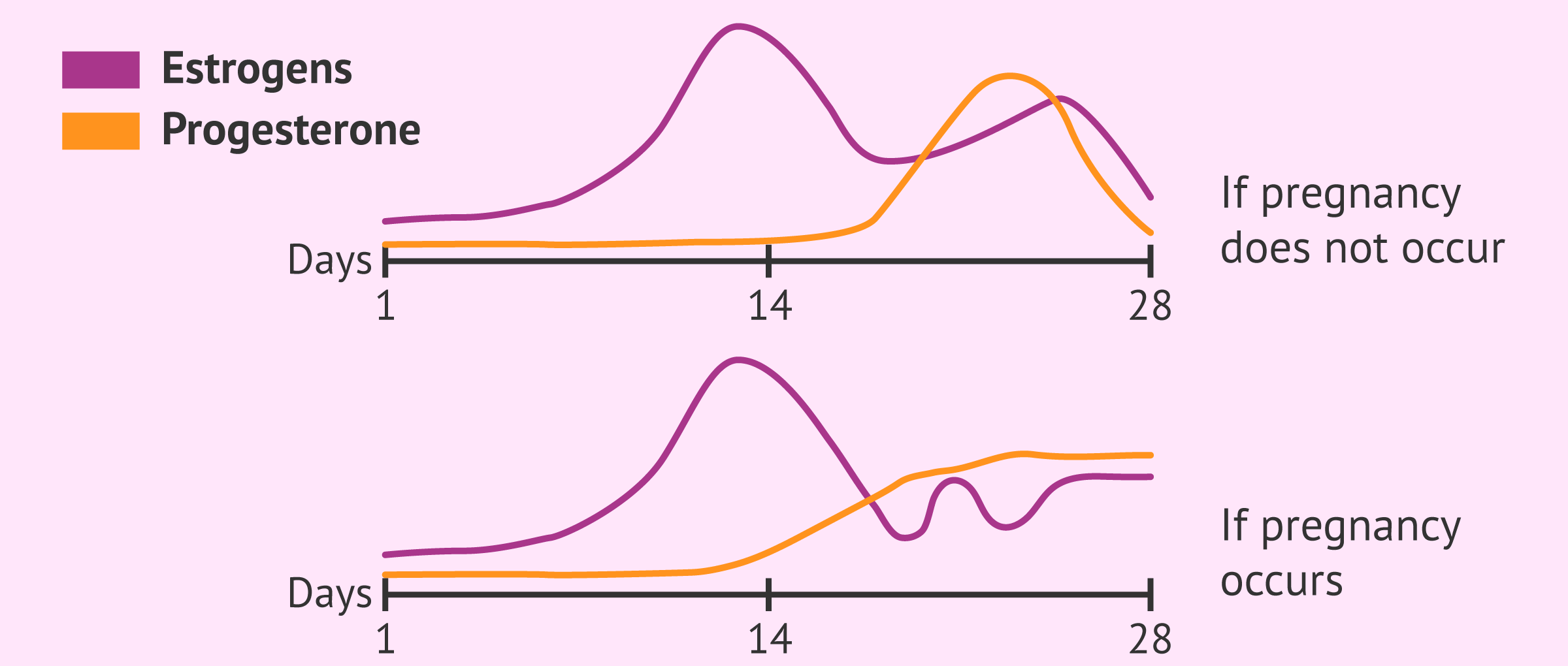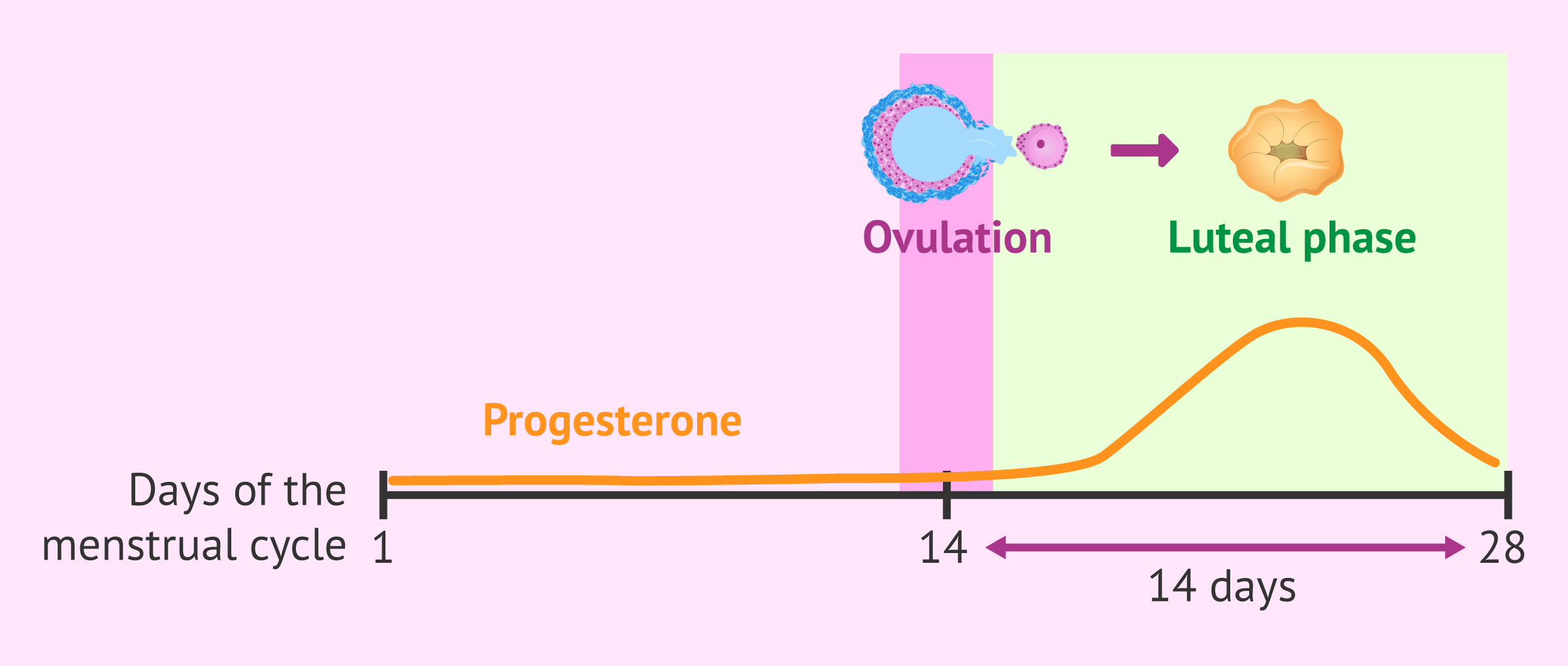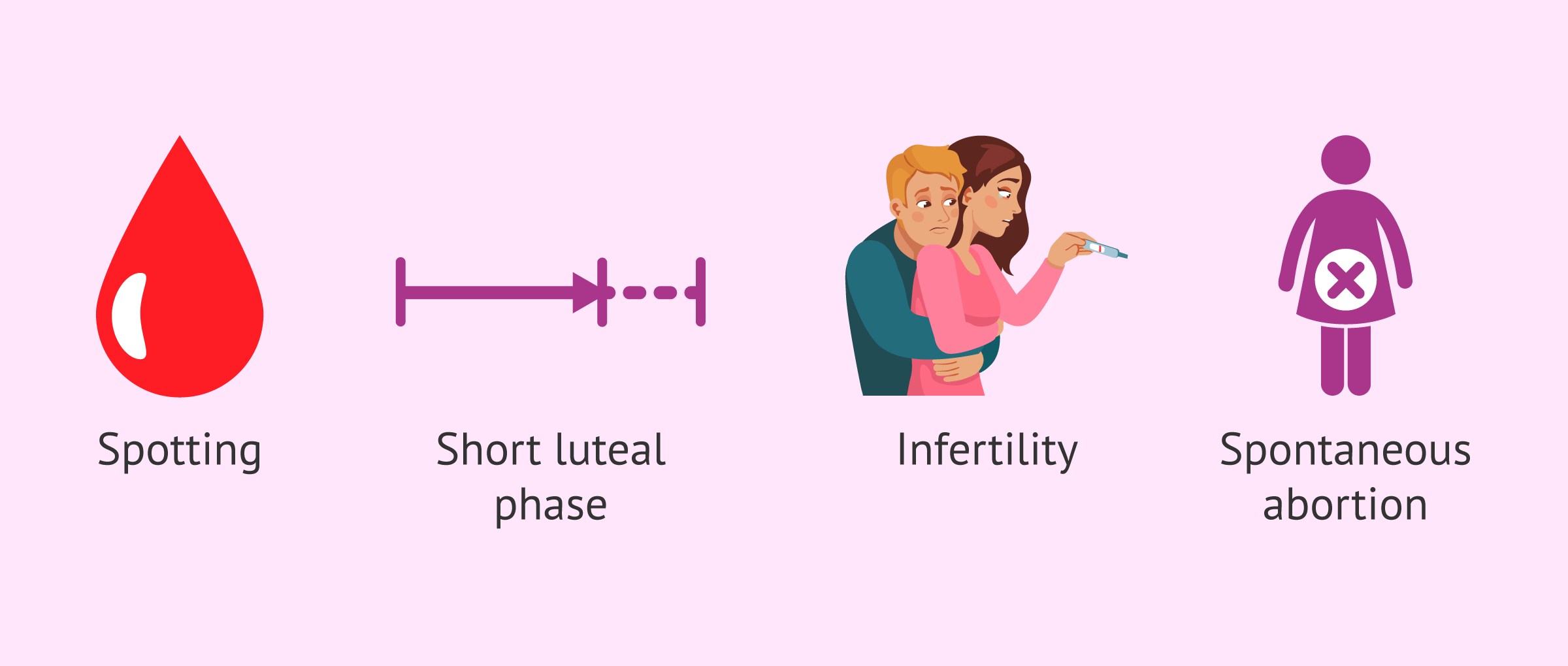The luteal phase is an important phase of the menstrual cycle, since in this phase the body prepares for a possible pregnancy. However, if the woman does not become pregnant, at the end of the luteal phase menstruation will be triggered, which is the beginning of a new menstrual cycle.
Progesterone, secreted by the corpus luteum, is the main hormone during the luteal phase. The action of progesterone on the uterine endometrium will cause it to adopt the optimal conditions to host the embryo in case a pregnancy occurs in that menstrual cycle.
Provided below is an index with the 8 points we are going to expand on in this article.
- 1.
- 2.
- 2.1.
- 2.2.
- 3.
- 4.
- 5.
- 5.1.
- 5.2.
- 5.3.
- 5.4.
- 6.
- 7.
- 8.
What is the luteal phase?
The term luteal phaserefers to one of the phases of a woman's menstrual cycle. The menstrual cycle is divided into three phases:
- Follicular Phase
- the development of several ovarian follicles occurs, although only one, the dominant follicle, will complete it. The follicular phase lasts from the onset of menstruation (beginning of the menstrual cycle) until ovulation occurs.
- Ovulation
- the dominant follicle (which has completed its development and is now called Graaf's follicle) releases the egg inside it, which will be picked up by the fallopian tubes.
- Luteal phase
- the empty follicle left in the ovary after ovulation gives rise to the corpus luteum, which gives its name to this phase. The luteal phase begins once ovulation occurs and lasts until the time of a new menstrual period if the woman has not become pregnant. The arrival of the menstrual period will mean the beginning of a new menstrual cycle.
Therefore, the luteal phase corresponds to the postovulatory period of the menstrual cycle. During this period, the woman's body prepares for a possible pregnancy or, if this does not happen, for the next menstruation to occur.
You can read more information about the menstrual cycle in this article: The menstrual cycle: what happens in each of its phases?
What happens in the luteal phase?
Throughout the menstrual cycle, changes occur not only at the ovarian level, but also in the uterus. The uterine endometrium (the layer that lines the inside of the uterus) is the place where the embryo must implant in order to give rise to a gestation and, therefore, it is prepared in each cycle in case this occurs.
Therefore, we will explain what events occur during the luteal or postovulatory phase of the menstrual cycle in each of these organs.
In the ovary
As mentioned above, the remains of the empty follicle after ovulation give rise to the corpus luteum in the ovary. The corpus luteum begins to secrete estrogen and, mainly, progesterone.
If pregnancy does not occur, the corpus luteum is maintained for only 11-14 days after ovulation and degenerates. For this reason, progesterone and estrogen levels will drop.
The drop in progesterone levels at the end of the luteal phase may cause a woman to notice certain symptoms, known as premenstrual syndrome. These symptoms may include mood swings, fatigue, headache, acne and breast tenderness.
Conversely, if the woman becomes pregnant, the corpus luteum remains thanks to the hormone human chorionic gonadotropin(hCG or the"pregnancy hormone") secreted by the embryo. Thus, the corpus luteum will be in charge of continuing to produce progesterone to maintain the pregnancy early, until the placenta takes over this task.
In the uterus
First, it is important to remember that the uterine lining has been shed at the beginning of the menstrual cycle with menstruation. However, the endometrium goes through a proliferative phase and grows again throughout the ovarian follicular phase.
Now, during the luteal phase and thanks to the progesterone released by the corpus luteum, the endometrium becomes secretory(secretory phase) and produces certain substances to prepare for a possible implantation.
If the woman does not become pregnant, the drop in estrogen and progesterone levels (due to the disintegration of the corpus luteum) will trigger the endometrium to shed at the end of the luteal phase. Therefore, menstruation will come and, with it, the beginning of the next menstrual cycle.
However, as mentioned above, if the woman becomes pregnant, the corpus luteum is maintained by the hCG produced by the embryo and will secrete progesterone to support the early pregnancy. Because of this, progesterone levels do not decline and, as a result, menstruation does not occur and menstrual cycles cease during pregnancy.
How long does the luteal phase last?
Normally, the luteal phase lasts about 14 days on average (between 12 and 16 days) and has a more stable duration than the follicular phase.
Since the luteal phase extends from ovulation to the next menstruation, in a typical 28-day menstrual cycle, the luteal phase would span from day 14 to day 28. However, the onset of the luteal phase will depend on the time at which ovulation occurs, which may even vary between menstrual cycles in the same woman.
However, there are different methods to estimate when ovulation occurs and, therefore, when a woman enters the luteal phase of the menstrual cycle. These include observation of the characteristics of cervical mucus (similar to raw egg white at the time of ovulation), measurement of basal body temperature (which increases 0.5 oCdue to the effect of progesterone after ovulation and during the luteal phase) or ovulation tests that detect the LH hormone in urine.
You can read more information about all of them in the following article: What are the signs of fertility in women?
Luteal phase insufficiency
Luteal phase insufficiency refers to a disorder in which progesterone levels are not adequate during the luteal phase or there is endometrial resistance to progesterone and, therefore, the endometrium may not acquire optimal conditions for implantation. This could lead to problems in achieving pregnancy or for the pregnancy to develop normally. Symptoms of luteal phase insufficiency include:
- Spotting or irregular menstruation.
- Short luteal phase, 10 days or less.
- Basal temperature that is slow to rise or does not rise much.
- Difficulties in achieving pregnancy.
- Spontaneous abortion.
Therefore, the diagnosis is often made when the couple comes to a fertility clinic because of problems conceiving or because they have had several miscarriages. However, there is some controversy regarding luteal phase insufficiency and diagnosis can be difficult. This is based, in many cases, on tests to determine progesterone levels on day 21 of the menstrual cycle (if this is less than 10 ng/ml) and on endometrial biopsy.
Considering undergoing a fertility treatment? By getting your individual Fertility Report your will see different clinics especially selected for you out of the pool of clinics that meet our strict quality criteria. Moreover, it will offer you a comparison between the fees and conditions each clinic offers in order for you to make a well informed choice.
As for treatment, it sometimes involves only lifestyle changes, for example, to reduce stress. Medical treatment may consist of exogenous administration of progesterone, hCG or gonadotropins, depending on the particular situation.
FAQs from users
Is pregnancy with luteal phase insufficiency possible?
Antonio Forgiarini, gynaecologist at Next Fertility Valencia, explains in this video whether it is possible to achieve a pregnancy despite an insufficient luteal phase:
Yes it's possible, especially because we don't know if luteal insufficiency is a real problem or not, especially in natural cycle because they are very variable. Normally, when we suspect this problem we can add progesterone. Progesterone is the principal hormone during the lutal phase, so we can add it during the second phase of the menstrual cycle in a natural cycle or after a reproductive treatment we usually always add progesterone during the lutal phase.
Can I get pregnant during the luteal phase?
For pregnancy to occur, the woman must have ovulated and, therefore, at the time of conception and subsequent implantation of the embryo in the uterus, the woman will be in the luteal phase.
However, the ovum survives only 12-24 hours after ovulation, while the sperm can survive for 3-5 days in the female reproductive tract. Therefore, it is recommended to have sexual intercourse (every other day) during the 3-5 days prior to ovulation, the day of ovulation and the day after, as these are the woman's most fertile days.
This means that, although pregnancy as such occurs in the luteal phase, sexual intercourse should take place before or on the first day of the luteal phase.
What is the middle luteal phase?
Mid-luteal phase refers to the time when a woman is in the middle of the luteal phase.
In a typical 28-day menstrual cycle, the luteal phase extends from day 14 to day 28. Therefore, a woman will be in mid-luteal phase on day 21 of her menstrual cycle.
It is at this time that progesterone levels are determined from a blood test, which can help assess whether or not the woman has ovulated in that menstrual cycle.
Why does basal body temperature increase in the luteal phase?
In the luteal phase, the ovarian corpus luteum is responsible for producing progesterone. Increased levels of this hormone are responsible for the fact that, after ovulation and during the luteal phase, the woman's basal body temperature rises by 0.3-0.5 orC.
Some women use this method to estimate when ovulation has occurred and when they have entered the luteal phase. To do this, the basal temperature should be measured every day of the cycle before getting out of bed and with the same thermometer. In this way, with the recording of temperatures, the woman could detect the increase in her basal body temperature.
Suggested for you
If you want to know more about ovulation, we recommend you read the following article: When does ovulation occur and what are the symptoms?
On the other hand, if you want to know more about progesterone, you can access this link: Progesterone hormone: functions, normal values and medications
We make a great effort to provide you with the highest quality information.
🙏 Please share this article if you liked it. 💜💜 You help us continue!
References
Capozzi A, Scambia G, Lello S. Clinical pharmacology of progestins. Minerva Obstet Gynecol. 2022 Aug;74(4):364-376. doi: 10.23736/S2724-606X.21.04881-8. Epub 2021 Jun 28. PMID: 34180615. (View)
Duncan WC. The inadequate corpus luteum. Reprod Fertil. 2021 Feb 26;2(1):C1-C7. doi: 10.1530/RAF-20-0044. PMID: 35128435; PMCID: PMC8812462. (View)
Jaber RM, Alghzawi AO, Salameh HH. Premenstrual syndrome: consultation sources and the impact on women's quality of life. Afr Health Sci. 2022 Mar;22(1):80-87. doi: 10.4314/ahs.v22i1.10. PMID: 36032464; PMCID: PMC9382462. (View)
Labarta E, Rodríguez C. Progesterone use in assisted reproductive technology. Best Pract Res Clin Obstet Gynaecol. 2020 Nov;69:74-84. doi: 10.1016/j.bpobgyn.2020.05.005. Epub 2020 Jun 4. PMID: 32616441. (View)
Practice Committees of the American Society for Reproductive Medicine and the Society for Reproductive Endocrinology and Infertility. Diagnosis and treatment of luteal phase deficiency: a committee opinion. Fertil Steril. 2021 Jun;115(6):1416-1423. doi: 10.1016/j.fertnstert.2021.02.010. Epub 2021 Apr 4. PMID: 33827766. (View)
Saxtorph MH, Hallager T, Persson G, Petersen KB, Eriksen JO, Larsen LG, Hviid TV, Macklon N. Assessing endometrial receptivity after recurrent implantation failure: a prospective controlled cohort study. Reprod Biomed Online. 2020 Dec;41(6):998-1006. doi: 10.1016/j.rbmo.2020.08.015. Epub 2020 Aug 21. PMID: 32978074. (View)
Suthaporn S, Jayaprakasan K, Thornton J, Walker K, Medrano JH, Castellanos M, May S, Polanski L, Raine-Fenning N, Maalouf WE. Suboptimal mid-luteal progesterone concentrations are associated with aberrant endometrial gene expression, potentially resulting in implantation failure. Reprod Biomed Online. 2021 Mar;42(3):595-608. doi: 10.1016/j.rbmo.2020.10.018. Epub 2020 Nov 4. PMID: 33608186. (View)
Tesarik J, Mendoza-Tesarik R. Molecular Clues to Understanding Causes of Human-Assisted Reproduction Treatment Failures and Possible Treatment Options. Int J Mol Sci. 2022 Sep 8;23(18):10357. doi: 10.3390/ijms231810357. PMID: 36142268; PMCID: PMC9499616. (View)
FAQs from users: 'Is pregnancy with luteal phase insufficiency possible?', 'Can I get pregnant during the luteal phase?', 'What is the middle luteal phase?' and 'Why does basal body temperature increase in the luteal phase?'.






